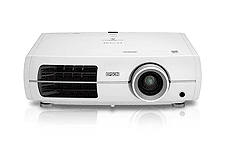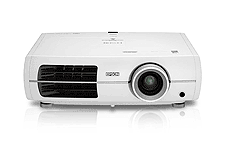


Epson has released its newest top-shelf projectors, the Home Cinema 8700 UB and the Pro Cinema 9700 UB (which is essentially identical to the 8700 but sold through custom channels; it comes with an extra lamp, ceiling-mount hardware, and a rear-panel cable cover). These two projectors won't be the company's top-shelf models for long, as Epson will soon release a brand new high-end line that employs 3LCD Reflective technology. The Reflective models will be priced in the mid-level range (around $3,300 to $7,000), while these traditional 3LCD projectors fall in the entry-level category. The 8700 UB has an MSRP of just $2,199 and a street price under $2,000. I had a chance to spend some quality time with this projector and found that, while it has essentially the same complement of features as last year's 8500 UB, the 8700 UB boasts improved performance and a lower price. That's always a welcomed combination.
Additional Resources
• Read more video projector reviews from HomeTheaterReview.com.
• Find a great projector screen for the 8700 UB.
Features
The Home Cinema 8700 UB is a THX-certified 2D projector with a 1920 x 1080 resolution that uses the D7 C2Fine TFT LCD chipset with UltraBlack technology and the Silicon Optix HQV Reon-VX processing chip. It features an auto iris to produce a higher dynamic contrast ratio, Super-resolution+ technology to improve the image's sharpness and apparent detail, a 120Hz FineFrame mode and 4:4 pulldown to reduce film judder, and an anamorphic wide aspect ratio for use with an optional anamorphic lens attachment. Epson quotes a light output of 1,600 lumens and a dynamic contrast ratio of 200,000:1. This projector supports a screen size up to 100 inches diagonally and uses a 200-watt E-TORL lamp with a rated life of 4,000 hours.
The 8700 UB has the same thorough assortment of inputs, physical setup tools, and picture adjustments that we've come to expect from Epson. The input panel includes dual HDMI 1.3 inputs, a PC port, RS-232, and a 12-volt trigger. In terms of physical setup, you get 2.1x manual zoom, 96 percent vertical and 47 percent horizontal lens shift (via manual dials on the top panel), adjustable feet, and an onscreen test pattern to aid with sizing and focus. I positioned the projector on top of my vertical equipment rack in the back of the room, about four feet high and 12 feet from my 75-inch-diagonal Elite Screens theater screen. The 8700 UB sports seven preset color modes, including a THX mode that's designed to offer the most accurate image out of the box. The projector also offers brighter color modes that have ample light output for a well-lit room.
The 8700 UB has pretty much every advanced picture adjustment that you or your installer could want, including: high and low lamp modes, RGB offset and gain controls to precisely calibrate white balance, advanced gamma, noise reduction, skin-tone adjustment, and an advanced color management system to adjust the hue, saturation, and brightness of all six color points. You have the option to turn on Epson's 120Hz FineFrame technology, which uses frame interpolation to render smoother motion in film sources, or you can enable 4:4 pulldown, which will output 24p Blu-ray sources at 96 Hz. The latter results in smoother, less juddery motion than the traditional 3:2 process but does not alter the character of film motion the way frame interpolation does. You can turn the auto iris on or off and designate a speed of normal or high, and you can choose a level for Super-resolution+, with options for off, 1, 2, and 3. The 8700 UB allows you to set different image parameters for each picture mode, as well as different parameters for standard- and high-definition sources within each picture mode. The projector automatically recalls these adjustments, but the 8700 UB will also store 10 different setups in its memory.
The 8700 UB offers six aspect-ratio choices: auto, normal, full, zoom, wide, and anamorphic wide. If you own an anamorphic lens and a 2.35:1 screen, the anamorphic wide mode allows you to view 2.35:1 movies with no black bars at the top and bottom, thus devoting the projector's entire resolution to the actual film image. The setup menu also allows you to adjust the amount of overscan, with options for auto, off, 2%, 4%, 6%, and 8%.

Performance
As I do with all THX-certified displays, I began my review by watching content at the default THX settings, and I was pleased with what I saw. Interesting, in the Epson's default configuration, the THX mode turns off touted features like 120Hz FineFrame, Super-resolution+, and the auto iris. Of course, you can turn these on if you choose, but it does give you an idea how THX feels about these modes from a video-purist perspective. The only thing you can't do in the THX mode is adjust the basic color-temperature and skin-tone controls; if you feel the need to alter these parameters, you have to use the RGB offset/gain controls, which is best left to a professional calibrator with the proper measurement tools. I found the THX mode's color temperature and skin tones to look neutral and natural with both bright and dark content, at least in the normal lamp mode. To my eyes, the normal lamp mode served up a respectably bright image yet still produced a deep shade of black, resulting in excellent contrast and a rich, inviting image. To my ears, this year's normal lamp mode was quieter than last year's model. Fan noise was not a distraction even during quieter scenes, despite the fact that the projector was located right behind my seating area. I didn't feel the need to switch to the darker eco lamp mode: Even though its lower light output can provide longer lamp life, slightly quieter operation, and a slightly deeper shade of black, the eco mode also alters the color temperature, adding an obvious green push. Since you can't access the basic color-temp and skin-tine controls in the THX mode, you'd have to do an advanced calibration to correct this issue. If you'd really prefer to use the eco lamp mode, I recommend you start with one of the Theater Black color modes instead of the THX mode; these modes offer more freedom to adjust basic color temp and skin tone without having to do an advanced calibration.

All in all, I was impressed with the 8700 UB's performance with both
SD and HD, both TV and film content. As I said above, the projector
produces deep blacks and excellent contrast for its low price point. At
its normal setting, the auto iris works quietly and effectively,
without producing obvious brightness shifts. The projector's ability to
render fine black detail is excellent. Its color points look natural;
blues had a slightly bluish-green quality, but otherwise I saw no
obvious exaggeration or over-saturation. The image is clean, with
little to no digital noise in backgrounds and light-to-dark
transitions.
Both SD and HD images have a solid level of detail, although the
picture might appear a bit soft on a larger screen. You need to be
careful how you adjust this projector's sharpness control. Set it too
low, and the picture gets soft. Set it too high, and you will see edge
enhancement. Compared with last year's model, the Super-resolution+
technology appears to do a better job of improving the sharpness of
fine details without introducing obvious edge enhancement. I found a
setting of 1 or 2 to do a very good job of sharpening up the fine lines
and background details in standard-def signals, helping the image to
look more crisp and detailed (the highest setting of 3 created more
obvious edge enhancement, so I don't recommend it). Add in the fact
that the video processor reliably deinterlaces 480i film content,
producing minimal artifacts, and I think you'll be happy with what the
8700 UB can do with your standard-def DVD collection.
Epson's 120Hz FineFrame technology also gets better with each
generation. Although I still prefer 4:4 pulldown for 24p film sources,
the low FineFrame mode is subtle enough to create smoother motion with
DVD and Blu-ray sources without dramatically altering the look of film.
This year's implementation was a bit more reliable with TV signals;
oftentimes, these frame-interpolation modes don't place nicely with my
DirecTV service, adding a lot of stuttering and smearing artifacts. In
this respect, the 8700 UB produced a more watchable image, although I
still recommend you use FineFrame only with DVD/Blu-ray content.
Competition and Comparison
Compare the Epson Home Cinema 8700 UB with its competition by reading
the reviews for the Sanyo PLV-Z4000,
Optoma HD20,
Mitsubishi HC8600,
and Epson Pro Cinema 9500 UB.
Learn more about projectors by visiting our projector
section.
High Points
• The Home Cinema 8700 UB produces a very attractive image, with great blacks and contrast for a $2,000 projector.
• This 1080p projector can accept 24p sources, offering 4:4 pulldown to reduce judder.
• The 120Hz FineFrame technology continues to get better. The low mode is subtle but effective at producing smooth motion.
• The 8700 UB has dual lamp modes, and its brightest picture mode
produces a well-saturated but still fairly natural-looking image in a
well-lit room.
• The projector has two HDMI inputs, as well as 12-volt triggers and an RS-232 port.
• It offers generous zoom and lens-shift capabilities for easy setup.
• An anamorphic mode is available, if you'd like to mate the projector with an anamorphic lens system.
Low Points
• The zoom, focus, and lens-shift controls are manual, not motorized.
• The 8700 UB's deinterlacing of 1080i signals could be better. I saw
some moiré in my demo scenes from Mission Impossible III and Ghost
Rider; however, I didn't see blatant artifacts with 1080i HDTV content.
• When I fed the 8700 UB the HDMI signal directly from my DirecTV HD
DVR, the projector was a little slow to switch between resolutions and
occasionally had handshake problems when switching between resolutions.
This won't be an issue if you feed the projector a constant 1080p
signal from your A/V receiver or external scaler.
• The 8700 UB is not a 3D-capable projector.
Conclusion
I can find very little to fault with Epson's Home Cinema 8700 UB. It
simply produces a pleasing image with minimal setup effort, and it has
all the features people want to see in their projectors these days: THX
certification, 120Hz, 4:4 pulldown, an auto iris, and an anamorphic
mode. Yet it still comes in at a street price under $2,000. If you're
looking to put together a high-quality theater on a budget, this
projector absolutely belongs on your must-see list.